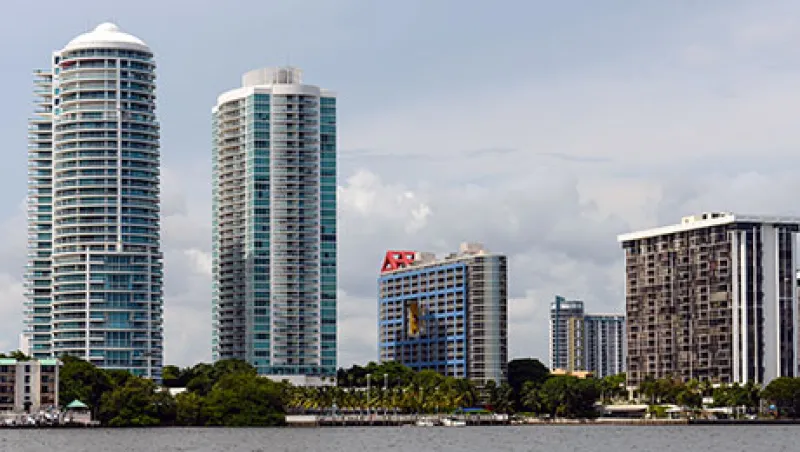The South Florida real estate market, which includes Miami-Dade, Broward and Palm Beach counties, has enjoyed a strong rebound over the past six years from the meltdown of 2007–’09. But some analysts say a bubble may be percolating in the condominium market, especially in Miami, which has seen a huge influx of foreign buying.
“South Florida is in a big bubble for high-end condos,” says Jack McCabe, an independent residential real estate analyst in Deerfield Beach, Florida, who correctly forecast the rout in the 2000s. The bubble is different this time around, he says. “Last decade it was U.S. real estate causing a U.S. recession, causing a global recession. This decade it’s a global recession that will end up causing a U.S. recession, causing a decline in the U.S. housing market.” Things aren’t so dire for other sectors of South Florida real estate, analysts say.
As for condos, Miami is experiencing a building boom. Since 2011, Miami-Dade County has seen 3,729 units completed in the upscale section east of Interstate 95, according to research firm CraneSpotters.com. And there are another 33,137 units under construction, planned or proposed.
More than 70 percent of new-condo buyers in Miami-Dade are foreign, with most coming from Latin America, McCabe says. Much of that Latin American buying represents investors pulling money from the region amid concern about economic weakness and political turmoil. But that trend can easily reverse, analysts warn. “If there’s capital that’s predicated more on investment than on fundamentals, you have to be careful,” says Ryan Severino, senior economist at real estate research firm Reis in New York City. “Capital could flee.”
To be sure, not everyone sees the Latin American condo buying as a problem. “Latin American people have paid more than they needed to, but they are still ahead of the game, because the Chavistas aren’t taking their money away,” says James Costello, senior vice president of New York–based Real Capital Analytics, a real estate research firm. The prices Latin Americans are paying for their Miami condos may be irrational for people in the U.S., but U.S. residents can protect their capital in other ways. For Latin Americans, it’s rational based on their needs for capital preservation, he says.
The median price for existing condos in Miami-Dade jumped 9.5 percent in the 12 months through February, to $206,950 from $189,000 a year ago. Condo prices have increased in 56 of the past 57 months.
The real problem is that the bulk of condos planned and being built for the future are at the high end, priced $400,000 and up, McCabe says. “There is very little in new residential construction in price ranges that would be affordable.” Indeed, if you define “affordable” as annual payments totaling 28 percent or less of the median South Florida annual household income of $56,000, then 90 percent of new construction is affordable to only 10 percent of residents, he says.
And McCabe notes that the number of condo sales already is starting to drop. The total fell 5.8 percent in February, to 2,039 from 2,165 a year earlier, according to the Miami Association of Realtors. “Developers say they see decreased traffic for new units, and they’re concerned,” he says.
Billionaire real estate investor Jeff Greene, who has spent more than $300 million on properties in West Palm Beach and Palm Beach, says he knows plenty of people who took gains they made from stocks and art and put some of the proceeds into Miami condos. But they are coming to regret their decision, he says. “The market is softening quickly.” He and other experts agree that many condo projects planned and proposed for Miami will end up on hold.
Outside of the condo market, South Florida real estate is expensive but not out of control, analysts say. Whereas the spread of commercial capitalization rates over mortgage rates has shrunk to 130 basis points from 250 basis points three years ago, that spread actually turned negative during the peak of the real estate boom in 2007, according to Real Capital Analytics. The negative spread showed that investors had excessive optimism for returns, Costello says. Today the spread indicates “investors aren’t counting on double-digit growth forever to make it work,” he says.
Much of the drop in cap rates stems from lower interest rates, Reis’s Severino notes. And even so, cap rates still remain above the nadir of last decade’s boom: The South Florida commercial cap rate now stands at 6.3 percent, above the 6.1 percent trough recorded in 2007, according to Real Capital Analytics. “You have to be careful if you’re investing, because we’re near the top of the [South Florida] market,” Severino says. “But it’s important to differentiate between pricey and a bubble. I don’t think we’re in a bubble now, though that doesn’t preclude the possibility we will fall into one.”







